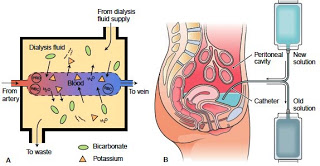My attention was caught by the recent article in CJASN which
compared the mortality of peritoneal dialysis (PD) and hemodialysis (HD) patients
in the first 2 years of dialysis therapy. When comparing survival outcomes of
PD and HD patients, the data we have so far is based on observational studies.
A randomized controlled study has never been successfully completed because of
difficulties in randomization. The only randomized study so far – the NECOSAD study (Netherlands) managed to randomize only 5% of the eligible subjects3.
compared the mortality of peritoneal dialysis (PD) and hemodialysis (HD) patients
in the first 2 years of dialysis therapy. When comparing survival outcomes of
PD and HD patients, the data we have so far is based on observational studies.
A randomized controlled study has never been successfully completed because of
difficulties in randomization. The only randomized study so far – the NECOSAD study (Netherlands) managed to randomize only 5% of the eligible subjects3.
Most of the observational studies looking at survival had methodological
limitations like suboptimal adjustment for modality switch over time (PD
patients more likely to switch to HD), inability to account for time-varying
confounding by laboratory values and inappropriate adjustment for the
differential longitudinal censorship of transplantation across modalities (PD
patients more likely to get a transplant). While analyzing such time-varying covariates
which are simultaneously confounders as well as predictors of outcome and
subsequent exposure, traditional methods like logistic or proportional hazards
regression are biased and hence they pose unique analytical challenges. Hence
a new statistical model – a Marginal Structural Model (MSM) which employs inverse probability weights (IPWs) to
determine the effects of these time varying covariates on the primary outcome
(which was survival in this study) was
utilized in this study. In order to
adjust for the effect of each dialysis modality and censorship from transplantation,
a combination of inverse probability of treatment weights (IPTWs) and inverse
probability of censoring weights (IPCWs) was used. The IPTW (or IPCW) will have
estimated probabilities of treatment (or censorship) using baseline covariates
as the numerator and estimated probabilities of treatment (or censorship) using
baseline and time-dependent covariates as the denominator. The MSM helped to
derive meaningful survival data, adjusting for the above mentioned confounders
limitations like suboptimal adjustment for modality switch over time (PD
patients more likely to switch to HD), inability to account for time-varying
confounding by laboratory values and inappropriate adjustment for the
differential longitudinal censorship of transplantation across modalities (PD
patients more likely to get a transplant). While analyzing such time-varying covariates
which are simultaneously confounders as well as predictors of outcome and
subsequent exposure, traditional methods like logistic or proportional hazards
regression are biased and hence they pose unique analytical challenges. Hence
a new statistical model – a Marginal Structural Model (MSM) which employs inverse probability weights (IPWs) to
determine the effects of these time varying covariates on the primary outcome
(which was survival in this study) was
utilized in this study. In order to
adjust for the effect of each dialysis modality and censorship from transplantation,
a combination of inverse probability of treatment weights (IPTWs) and inverse
probability of censoring weights (IPCWs) was used. The IPTW (or IPCW) will have
estimated probabilities of treatment (or censorship) using baseline covariates
as the numerator and estimated probabilities of treatment (or censorship) using
baseline and time-dependent covariates as the denominator. The MSM helped to
derive meaningful survival data, adjusting for the above mentioned confounders
The study used information from two large databases viz. USRDS
and Da Vita, providing a large cohort of almost 24000 incident dialysis patients.
Separate analysis was conducted using a Kaplan–Meier survival curve, cox proportional
hazards and the MSM model. A 48% greater survival for incident PD patients at 2
years was found using the MSM model. These findings were in contrast to
findings in other studies in the past which showed either no difference in
survival or marginal survival advantage especially in the first year for PD
compared to HD5. Additionally, a comparison between the cox model and the MSM demonstrated
that the time-dependent confounders determined the difference in survival.
Changes in modality during the first 2 years of dialysis affected the survival
patterns over time and the reason for this trend is not completely understood
at this point. This study supports greater use of PD in the treatment of ESRD
patients especially in US where less than 8% of prevalent patients with ESRD are on PD.A
comprehensive dialysis modality education program should be encouraged to
expand the practice of PD.
and Da Vita, providing a large cohort of almost 24000 incident dialysis patients.
Separate analysis was conducted using a Kaplan–Meier survival curve, cox proportional
hazards and the MSM model. A 48% greater survival for incident PD patients at 2
years was found using the MSM model. These findings were in contrast to
findings in other studies in the past which showed either no difference in
survival or marginal survival advantage especially in the first year for PD
compared to HD5. Additionally, a comparison between the cox model and the MSM demonstrated
that the time-dependent confounders determined the difference in survival.
Changes in modality during the first 2 years of dialysis affected the survival
patterns over time and the reason for this trend is not completely understood
at this point. This study supports greater use of PD in the treatment of ESRD
patients especially in US where less than 8% of prevalent patients with ESRD are on PD.A
comprehensive dialysis modality education program should be encouraged to
expand the practice of PD.
Posted by Bijin Thajudeen




I recommend reading the accompanying editorial by Winkelmayer which discusses the limitations of interpreting MSM in a clinically meaningful way. (CJASN April 05, 2013 8): (4) 520-522)